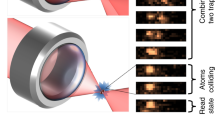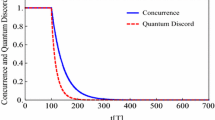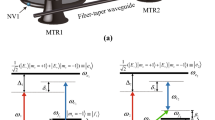Abstract
Many-spin entanglement is investigated in a gas of spin-carrying molecules (atoms) in a nanopore under NMR conditions with a dipolar ordered initial state. To estimate the number of entangled spins, the second moment of the distribution of the intensities of multiple quantum (MQ) NMR coherences is used, which provides a lower bound for the quantum Fisher information. Many-spin entanglement is investigated at different temperatures and different numbers of spins.



Similar content being viewed by others
REFERENCES
M. A. Nielsen and I. L. Chuang, Quantum Computation and Quantum Information (Cambridge Univ. Press, Cambridge, 2009).
F. Arute, R. Babbush, J. C. Bardin, et al., Nature (London, U.K.) 574, 505 (2019).
J. Baum, M. Munowitz, A. N. Garroway, and A. Pines, J. Chem. Phys. 83, 2015 (1985).
G. B. Furman, V. M. Meerovich, and V. L. Sokolovsky, Phys. Rev. A 78 (2008).
G. B. Furman, V. M. Meerovich, and V. L. Sokolovsky, Quantum Inform. Proc. 8, 283 (2009).
E. B. Fel’dman and A. N. Pyrkov, JETP Lett. 88, 398 (2008).
E. B. Fel’dman, A. N. Pyrkov, and A. I. Zenchuk, Phil. Trans. R. Soc. London, Ser. A 370, 4690 (2012).
M. Gärttner, P. Hauke, and A. M. Rey, Phys. Rev. Lett. 120, 040402 (2018).
G. Tóth and I. Apellaniz, J. Phys. A 47, 424006 (2014).
L. Pezzé, A. Smerzi, M. K. Oberthaler, et al., Rev. Mod. Phys. 90, 035005 (2018).
J. Liu, H.-N. Xiong, F. Song, and X. Wang, Phys. A (Amsterdam, Neth.) 410, 167 (2014).
A. Khitrin, Chem. Phys. Lett. 274, 217 (1997).
S. I. Doronin, E. B. Fel’dman, and I. D. Lazarev, Phys. Rev. A 100, 022330 (2019).
J. Baugh, A. Kleinhammes, D. Han, and Q. Wang, Science (Washington, DC, U. S.) 294, 1505 (2001).
S. I. Doronin, A. V. Fedorova, E. B. Fel’dman, and A. I. Zenchuk, J. Chem. Phys. 131, 104109 (2009).
S. I. Doronin, E. B. Fel’dman, E. I. Kuznetsova, et al., Phys. Rev. B 76, 144405 (2007).
M. Goldman, Spin Temperature and Nuclear Magnetic Resonance in Solids (Clarendon, London, 1970).
C. P. Slichter and W. C. Holton, Phys. Rev. 122, 1701 (1961).
J. Jeener and P. Broekaert, Phys. Rev. 157, 232 (1967).
S. I. Doronin, E. B. Fel’dman, E. I. Kuznetsova, G. B. Furman, and S. D. Goren, JETP Lett. 86, 24 (2007).
S. I. Doronin, E. B. Fel’dman, and A. I. Zenchuk, J. Exp. Theor. Phys. 113, 495 (2011).
A. Abragam and M. Goldman, Nuclear Magnetism: Order and Disorder (Clarendon, London, 1982).
J. Baum and A. Pines, J. Am. Chem. Soc. 108, 7447 (1986).
C. M. Sánchez, R. H. Acosta, P. R. Levstein, et al., Phys. Rev. A 90, 042122 (2014).
M. Munowitz, A. Pines, and M. Mehring, J. Chem. Phys. 86, 3172 (1987).
G. A. Alvarez, D. Suter, and R. Kaiser, Science (Washington, DC, U. S.) 349, 846 (2015).
K. X. Wei, C. Ramanathan, and P. Cappellaro, Phys. Rev. Lett. 120, 070501 (2018).
E. B. Fel’dman and M. G. Rudavets, J. Exp. Theor. Phys. 98, 207 (2004).
E. B. Fel’dman and S. Lacelle, Chem. Phys. Lett. 253, 27 (1996).
W. Zhang, P. Cappellaro, N. Antler, et al., Phys. Rev. A 80, 052323 (2009).
D. Girolami and B. Yadin, Entropy 19, 124 (2017).
C. W. Helstrom, Quantum Detection and Estimation Theory (Academic, New York, 1976).
L. Pezzé and A. Smerzi, Phys. Rev. Lett. 102, 100401 (2009).
P. Hyllus, W. Laskowski, R. Krischek, et al., Phys. Rev. A 85, 022321 (2012).
G. Tóth, Phys. Rev. A 85, 022322 (2012).
ACKNOWLEDGMENTS
The authors are grateful to V.A. Atsarkin for a helpful discussion.
Funding
This work was carried out as a part of the state task (state registration no. AAAA-A19-119071190017-7). This work was partially supported by the Russian Foundation for Basic Research (project nos. 20-03-00147 and 19-32-80004). One of the authors (I.D.L.) acknowledges support from the Foundation for the Development of Theoretical Physics and Mathematics “Basis” (project no. 19-1-5-130-1).
Author information
Authors and Affiliations
Corresponding author
Additional information
Translated by I. Nikitin
APPENDIX
APPENDIX
1.1 Two-Pulse Broekaert–Jeener Experiment at Low Zeeman Temperature and High Dipolar Temperature
Initially, the system is in a state of thermodynamic equilibrium in a strong external magnetic field with the density matrix
where βL is proportional to the inverse temperature of the lattice. After the first resonant x-pulse, we obtain
where Iα is the operator of the projection of the total spin angular momentum onto the axis α = x, y, z. Then the system freely evolves over time τ, and after that a second resonant y-pulse is applied, which rotates the spins through angle θ around the y-axis of the RRF. As a result, we find that
After time T2 (T2 is the spin relaxation time [17]), the system reaches a state of thermodynamic equilibrium,
where αZ and βd are the inverse Zeeman and dipolar temperatures. It is obvious that the system has a single equilibrium state, and the temperatures αZ and βd in the equilibrium state are determined from the conservation laws:
We can rewrite Tr{Izσ'(τ)} as
In expression (A.7), we took into account that [exp(–iπIy), Hdz] = 0. Since we consider the case of a high dipolar temperature, Eq. (A.5) can be rewritten as
Notice that Tr{Iz} = Tr{IzHdz} = 0. In such a case, αZ = 0 satisfies Eq. (A.5). Thus, in this case we obtain a dipolar ordered state.
Rights and permissions
About this article
Cite this article
Lazarev, I.D., Fel’dman, E.B. Many-Spin Entanglement in Multiple Quantum NMR with a Dipolar Ordered Initial State. J. Exp. Theor. Phys. 131, 723–729 (2020). https://doi.org/10.1134/S1063776120110059
Received:
Revised:
Accepted:
Published:
Issue Date:
DOI: https://doi.org/10.1134/S1063776120110059




